Kitesurfing is relatively new and is therefore a mostly unregulated sport, and that's the way we want to keep it - because that's the way it's the most fun. Regardless of whether you are a beginner or an advanced kiter, there are a few basic "rules of the road" which we can all follow to keep kiting safe and enjoyable for everyone.
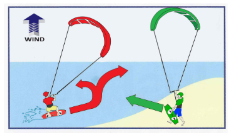
Coming on or off the water
Give way to riders entering the water. Being on the land with an LEI kite is more hazardous than being on the water so always allow others to enter the water even if this means having to take another tack before being able to return to the beach.
Passing other riders
When passing one another, upwind riders must put their kites up and downwind riders must put their kite down. However, amongst more experienced kiters you may find that kiters will move their kite or signal to show you which way they intend to move their kite. So long as both kiters can clearly see what the other kiter intends to do this shouldn't cause any problems.
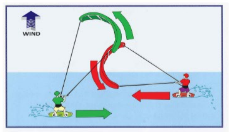
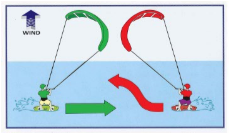
Riders on a colliding path
If on a colliding course, give way to riders on the starboard tack (this is generally right hand forward unless riding switch). If you are the more advanced rider of the two, you may find it easier to give way to the more novice kiter, as they will probably find it harder to manoeuvre than you would.
Novice Riders
Always give way to riders who are not in full control of their equipment, especially those who are students with instructors. It is likely that these people do not know how to avoid you or to recover if something were to go wrong, so always ensure you leave as much room around them as possible. If the beach you are riding at has a designated teaching zone then do not ride in this.
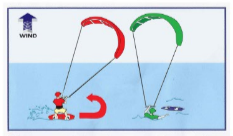
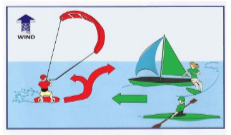
Other Water Users
As kitesurfing is the newest sport, technically you have the least priority over all other water users. Sometimes, more manoeuvrable crafts will get out of your way, but this is not always the case. It is important to remember that not all water users will know the rules of the road, so it is a good idea to presume you never have right of way. Even if you do have right of way, it is your responsibility to avoid a collision at all costs.
Additional Etiquette
There are a few other things you can do to ensure you (and everyone else!) has a fun and safe day at the beach.
- Know your limits - don't ride in conditions you are not fully confident in - If in doubt, don't go out!
- Make sure you have the right equipment - taking out the wrong size kite or faulty equipment puts you and others around you at risk
- Help other kiters launch and land - if everyone helps other people then no one has to self launch or land, this keeps everyone safer
- Stick to the designated kite zones; avoid teaching zones unless you are on a lesson!
- Remember that everyone was a beginner at some point, so don't be rude to people asking advice and help. If you're in a rush to get out, try and point them to a local school or someone with a bit more time - don't just leave them to fend for themself. Spending 10 minutes helping out a novice kiter might save you spending more time (and money!) repairing your kite if they crash into you.
- Check all around you before jumping, and never jump upwind of another kiter. Make sure you leave plenty of room when jumping - remember you may jump further or higher than planned (and you may also wipe out!)
- The first kiter to catch the wave has the wave - don't "snake" a wave from another kiter
If everyone sticks to the rules, kites safely and is friendly and helpful to other kiters, then kitesurfing can remain fun and relative unregulated. We're all out there for the same thrill of it, so remember to treat other kiters the way you'd want to be treated. You could make some pretty great friends down at the beach!
